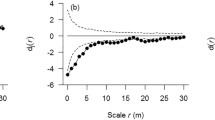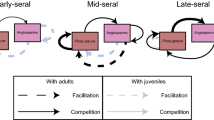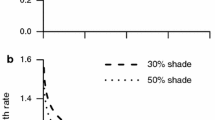Abstract
A method of detecting the density-dependent dynamics of a size-structured population is developed. The method is applied to a Japanese broad-leaved forest and the density-dependent and-independent projection matrix models are constructed based on the data of the forest. Then, the difference between the density-independent and density-dependent dynamics is compared in terms of several statistical quantities obtained from the matrices. Three kinds of sensitivity matrices are proposed for the density-dependent matrix model. At earlier stages, the sensitivity when the population density is low are higher than at the equilibrium. On the other hand, the inverse result is obtained at later stages. Moreover, the responses of the forest is analyzed to a decrease in survival rate and to an increase in the probability of gap formation. The decrease in survival rate leads to an extreme decrease in the density of the forest. However, the decrease in recruitment rate gives little effect on it because the effect of density-dependence in recruitment of new individuals is strong. The forest has the optimal rate of gap formation such that leads to the maximum population density.
Similar content being viewed by others
References
Alvarez-Buylla, E. R. & Garcia-Barrios, R. 1993. Models of patch dynamics in tropical forests. Trends Ecol. Evol. 8: 201–204.
Bierzychudek, P. 1982 The demography of jack-in-the-pulpit. A forest perennial that changes sex. Ecol. Monogr. 52: 335–351.
Burns, B. R., & Ogden, J. 1985. The demography of the temperate mangrove [Avicennia marina (Forsk.) Vierch.] at its southern limit in New Zealand. Austr. J. Ecol. 10: 125–133.
Caswell, H., 1987. A general formula for the sensitivity of population growth rate to changes in life history parameters. Theor. Popul. Biol. 14: 215–230.
Caswell, H. 1989 Matrix Population models—Construction, Analysis, and Interpretation—. Sinauer Associates, Inc. Publishers, Sunderland, Massachusetts.
Condit, R. 1995. Resaerch in large, long-term tropical forest plots. Trends Ecol. Evol. 10: 18–22.
Ford, E. D. 1975. Competition and stand structure in some even-aged plant monocultures. J. Ecol. 63: 311–333.
van, Groenendael, J., de, Kroon, H. & Caswell, H. 1988. Projection matrices in population. Trends Ecol. Evol. 3: 264–269.
Harcombe, P.A. 1986 Stand development in a 130-years-old spruce-hemlock forest based on age structure and 50 years of mortality data. forest Ecol. Mgmnt 14: 41–58.
Harcombe, P.A. 1987 Tree life tables. Simple birth, growth and death data encapsulate life histories and ecological roles. Bioscience 37: 557–574.
Hartshorn, G.S. 1975 A matrix model of tree population dynamics. In: Golley, F. B. & Medin, E. (eds), Tropical Ecological Systems: Trends in Terrestrial and Aquatic Research, pp. 41–51. Springer Verlag, New York.
Kawano, S., Takada, T., Nakayama, S., & Hiratsuka, A. 1987 Demographic differentiation and life-history evolution in temperate woodland plants. In: Urbanska, K. M. (ed) Differentiation patterns in higher plants. Academic Press, New York, pp. 153–181.
Keddy, P.A. 1982 Population ecology on an environmental gradient: Cakile edentula on a sand dune. Oecologia 52: 348–355.
Kinoshita, E. 1987 Sex change and population dynamics in Arisaema (Araceae) I. Arisaema serratum (Thumb.) Schott. Plant Species Biology 2: 15–28.
Kochummen, K. M. & LaFrankie, J. V. 1990. Floristic composition of Pasoh Forest Reserve, a lowland rain forest in Peninsular Malaysia. J. Trop. Forest Sci. 3: 1–13.
Manokaran, N. & LaFrankie, J. V. 1990. Stand structure in Pasoh Forest Reserve, a lowland rain forest in Peninsular Malaysia. J. Trop. Forest Sci. 3: 14–24.
Masaki, T., Suzuki, W., Niiyama, K., Iida, S., Tanaka, H. and Nakashizuka, T. 1992 Community structure of a species rich temperate forest, Ogawa Forest Reserve, central Japan. Vegetatio 98: 97–111.
Meagher, T. R. 1982 The population biology of Chamaelirium luteum, a dioecious member of the lily family: Two-sex population projections and stable population structure. Ecology 63: 1701–1711.
Nakashizuka, T. 1991 Population dynamics of coniferous and broad-leaved trees in a Japanese temperate mixed forest. J. Veget. Sci. 2: 413–418.
Nakashizuka, T., Iida, S., Tanaka, H., Shibata, M., Abe, S., Masaki, T. & Niiyama, K. 1992 Community dynamics of Ogawa Forest Reserve, a species rich deciduous forest, central Japan. Vegetatio 98: 1–8.
Osho, J. S. A. 1991 Matrix model for tree population projection in a tropical rain forest of southwestern Nigeria. Ecological Modelling 59: 247–255.
Pacala, S.W., Canham, C.D. & Silander, J.A., 1993 Forest models defined by field measurements 1: The design of a northeastern forest simulator. Canadian Journal of Forest Research 23: 1980–1988.
Peet, R. K., & Christensen, N. L. 1980 Succession: A population process. Vegetatio 43: 131–140.
Platt, W. J., Evans, G. W. & Rathbun, S. L. 1988 The population dynamics of a long-lived conifer (Pinus palustris). American Naturalist 131: 491–525.
Sarukhán, J. & Gadgil, M. 1974 Studies on plant demography: Ranunculus repens L., R. bulbosus L. and R. acris L. III. A mathematical model incroporating multiple modes of reproduction. Journal of Ecology 62: 921–936.
Schellner, R. A., Newell, S. J. & Solbrig, O. T. 1982 Studies on the population biology of the genus Viola. IV. Spatial pattern of ramets and seedlings in three stoloniferous species. Journal of Ecology 70: 273–290.
Solbrig, O. T., Sarandón, R. & Bossert, W. A. 1988 A density-dependent growth model of a perennial herb, Viola fimbriatula. American Naturalist 131: 385–400.
Stearns, S. C. 1992 The evolution of life histories. Oxford University Press, New York.
Takada, T. (1995) Evolution of semelparous and iteroparous perenial plants: Comparison between the density-independent and density-dependent dynamics. Journal of Theoretical Biology, 173: 51–60.
Takada, T. & Nakajima, H. 1992. An analysis of life history evolution in terms of the density-dependent Lefkovitch Matrix model. Mathematical Biosciences 112: 155–176.
Watkinson, A. R., & Harper, J. L. 1978 The demography of a sand dune annual Vulpia fasciculata: I. The natural regulation of populations. Journal of Ecology 66: 15–33.
Weiner, J. 1990 Asymmetric competition in plant populations. Trends in Ecology and Evolution 5: 360–364.
Welden, C. W., Hewett, S. W. Hubbel, S. P. & Foster, R. B. 1991 Sapling survival, growth, and recruitment: Relationship to canopy height in a Neotropical forest. Ecology 72: 35–50.
White, J., & Harper, J. L. 1970. Correlated changes in plant size and number in plant populations. J. Ecol. 58: 476–485.
Yoda, K., Kira, T., Ogawa, H. & Hodumi, K. 1963 Self-thinning in overcrowded pure stands under cultivated and natural conditions. Journal of Biology, Osaka City University 14: 107–129.
Author information
Authors and Affiliations
Rights and permissions
About this article
Cite this article
Takada, T., Nakashizuka, T. Density-dependent demography in a Japanese temperate broad-leaved forest. Vegetatio 124, 211–221 (1996). https://doi.org/10.1007/BF00045495
Received:
Accepted:
Issue Date:
DOI: https://doi.org/10.1007/BF00045495




